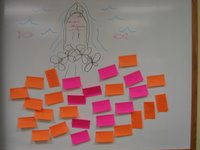
Two weeks ago, I led a session during the CHI 2007 conference entitled, "Moving User Experience into a Position of Corporate Influence: Whose Advice Really Works?"
As I described in
a preview, a major focus of the session was five means of -- according to many -- moving user experience into a position of corporate influence: documenting and evangelizing user experience work, owning the user experience, proper organizational positioning, calculating return on investment, and conducting "ethnographic" research. Indeed, according to many, each of these five means is critical to moving user experience into a position of corporate influence. However, one can find arguments against the use or importance of each means. Hence, of interest was which means played critical roles in moving user experience into a position of influence in the diverse mix of workplaces of six panelists, all in or having been in senior management positions via which they have moved user experience into a position of corporate influence.
During the session, I introduced each means, referencing arguments and evidence in support of the means, and referencing arguments and evidence to the contrary.

Then, after the audience members proclaimed whether or not they believed that particular means was critical to moving user experience into a position of corporate influence, the six panelists moved to a location on stage reflecting whether or not the means played a critical role in their workplaces (see sample slide).

Note the dissimilarity of the configuration of the panelists in the two nearby photos showing their configuration for two of the five means. Indeed, there was a lot of movement on stage during the session.

All six panelists were never together behind the same table, and different combinations of panelists were behind different tables (or "sitting on the fence" in the center) for all five means.
After moving into position for a means, panelists addressed how and/or why the means played or didn't play a critical role where they work.
So, what did the panelists say? Why is it that important words of advice regarding moving user experience into a position of corporate influence should be followed in some cases but not necessarily in all? When should one follow what advice?
The session, which received rave reviews, was recorded for addition to
ACM's Digital Library, so you'll all have an opportunity to learn answers to those questions as provided by the panelists via that recording. I'll let you know when the recording becomes available.
However, you can find partial answers to these questions in previous entries in my blog, and I'll address the panelists' answers and the session further in upcoming entries. (I hear that a couple of other people might also be preparing online reports about the session.)

Justin Miller's final words during the panel provide some good overarching guidance. After referring to Jakob Nielsen's stages of corporate usability maturity as providing some good guidance regarding when to do what, Justin said:
"But the really important thing is referenced in the very last sentence of Jakob's article: 'Once you learn how to tickle the organization sufficiently to make it move, you can start planning for your next upgrade...' You have to know how to influence your own organization, because that is what is going to make you successful. And that is going to be different from organization to organization, and within the same organization, it is going to vary over time. So, you've got to be plugged into how to change and influence things where you work, ... and you've got to be sure that you have the right capability (to do that)."
---
Justin Miller is Senior Director of Product -- Europe, eBay.
For a couple of my thoughts on Nielsen's stages of corporate usability maturity, see
Changing the course or pace of a large ship.
Photos courtesy of Nancy Frishberg.
 I'm delighted that lots of people and companies are finding value in my blog.
I'm delighted that lots of people and companies are finding value in my blog. Recently, UX Magazine -- a 2007 Webby Awards nominee for Best Business Blog, posted an entry from my blog and added another blog entry to their article editing queue.
Recently, UX Magazine -- a 2007 Webby Awards nominee for Best Business Blog, posted an entry from my blog and added another blog entry to their article editing queue.










